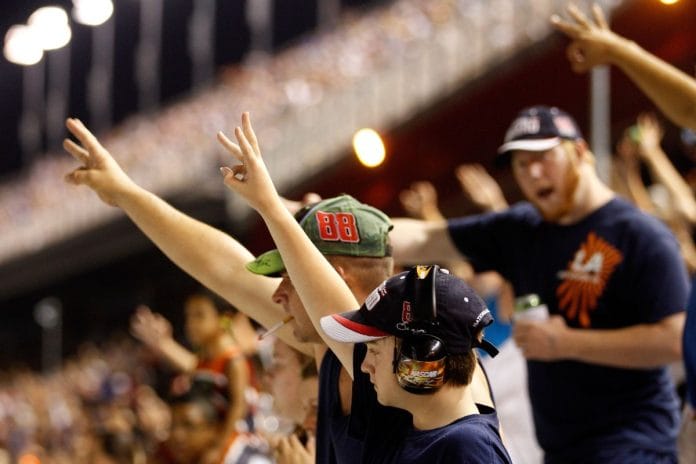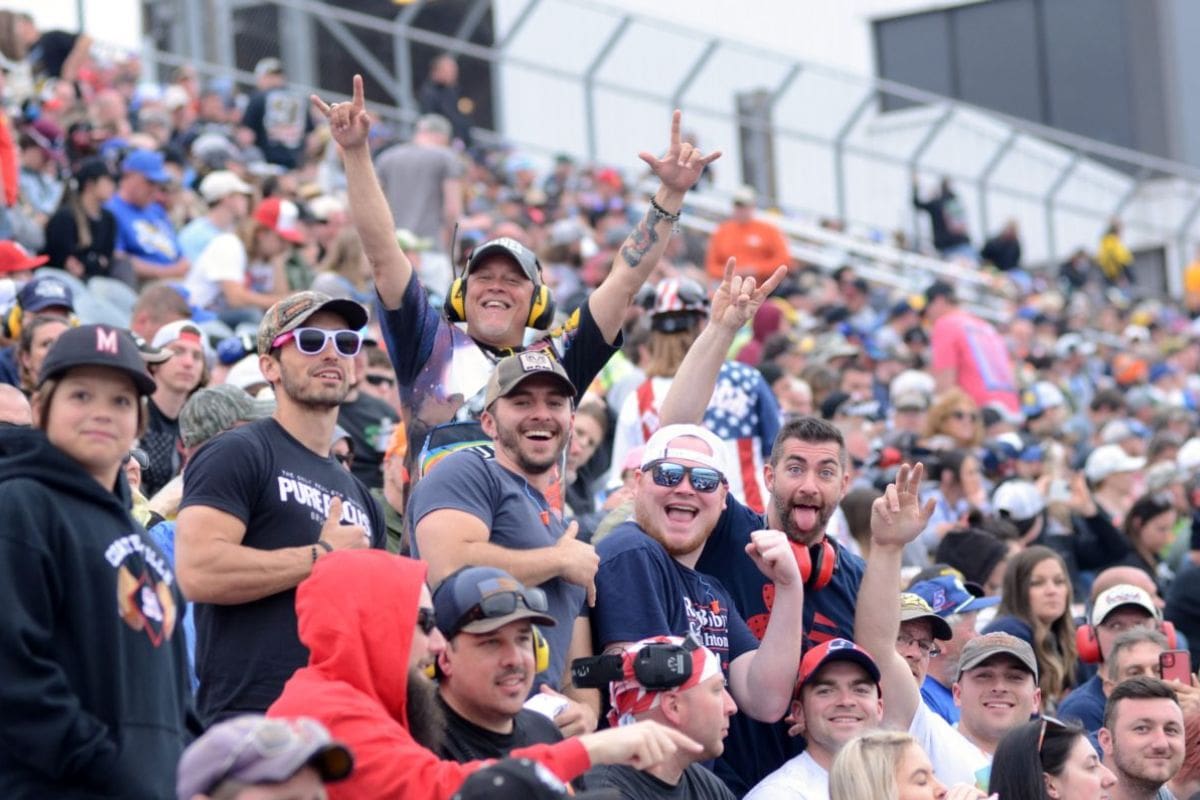Crane Mishap at Auto Club Speedway: In the wake of a recent mishap at Auto Club Speedway, fans are scrutinizing NASCAR’s ambitious move to convert the historic track into a short track. The incident has fueled speculation and debate, intertwining concerns about the planning and execution of the revamp with the track’s venerable history. As discussions intensify on social media, the community remains divided on whether the transformation is a bold step towards growth or a misstep endangering a beloved venue’s legacy.
Key Highlights
- Fans speculate supernatural forces opposed Auto Club Speedway’s transformation after the crane mishap during demolition.
- The crane accident caused substantial delays, raising fan concerns about NASCAR’s planning and safety protocols.
- Fans express frustration over diminished NASCAR presence in Southern California due to construction setbacks.
- The incident sparked debate over balancing modernization efforts with preserving Auto Club Speedway’s historical significance.
- Social media discussions highlight emotional reactions and fears of losing the track’s iconic identity.
NASCAR’s Ambitious Plan and Crane Mishap
In a attempt to revitalize Auto Club Speedway by converting it into a short track, NASCAR faced a notable setback when a massive crane toppled during the demolition phase. This mishap occurred amidst the ambitious transformation of the 2-mile D-shaped oval into a half-mile racing surface, a design inspired by the legendary short tracks of Bristol and Martinsville. This endeavor, deeply rooted in NASCAR’s strategy to improve fan engagement and racing dynamics, has now been marred by unforeseen complications.
The incident involving the crane not only caused significant delays but also raised safety concerns and logistical challenges. The crane’s collapse during the dismantling of the grandstands has inevitably extended the timeline for the project’s completion. Initially projected to take between 12 to 18 months, the renovations now face an indeterminate delay, casting doubt on NASCAR’s ability to meet the anticipated schedule.
This transformation was highly anticipated in the racing community, particularly since Kyle Busch’s victory in 2023 marked the last event on the original track. The mishap has thus amplified the stakes, as stakeholders and fans alike eagerly await the debut of the revamped venue. NASCAR’s dedication to delivering a modern, competitive short track experience hangs in the balance, with each delay potentially impacting the sport’s momentum.
Despite these setbacks, NASCAR remains committed to its vision. The organization must now navigate the complex process of reassessing and realigning project timelines, ensuring rigorous safety protocols, and maintaining transparent communication with its fan base. This incident highlights the inherent challenges of large-scale infrastructural overhauls within the sporting domain, reflecting the intricate balance between ambition and the unpredictable nature of construction endeavors.
Southern California NASCAR Market Impact
The recent setbacks in the transformation of Auto Club Speedway have greatly impacted NASCAR’s presence in the Southern California market, potentially diminishing the sport’s visibility and fan engagement in the region. The decision to dismantle the original Fontana track—which offered a distinctive racing experience not found in other ovals—has led to unforeseen complications, including noteworthy construction delays and safety incidents, such as the crane collapse shared by insider Justin Schuoler. This mishap, coupled with a partially demolished racing surface and standing grandstand, paints a troubling picture of the current state of the venue.
A crane fell over yesterday during demolition at Auto Club Speedway. #NASCAR pic.twitter.com/B4kk0PYTCY
— Justin Schuoler (@JSchuoler) July 18, 2024
With the Busch Light Clash anticipated to relocate from The Coliseum, Southern California’s NASCAR offerings have significantly diminished. The once-vibrant market now faces the clear reality of having no imminent NASCAR races, a development that could erode the fan base cultivated over decades. The original Fontana track was not just a racing venue; it was an integral part of the local motorsport culture. Its unique layout and racing dynamics were cherished by both drivers and fans, making its loss particularly poignant.
The delay and subsequent disruption in the Southern California market raise questions about the strategic decisions made by NASCAR. While the ambition to modernize and potentially improve the racing experience is commendable, the execution has clearly faltered, leading to a vacuum in a key geographic area. This market impact is not merely a logistical concern but a substantial risk to NASCAR’s broader aims of maintaining and growing its fan base.
Fan Reactions and Speculations
Fans have been vocal and speculative regarding the events at Auto Club Speedway, with some attributing the mishap to supernatural forces opposing NASCAR’s decision to revamp the historic venue. The incident involving a crane collapse during the demolition project has ignited a fervor of commentary, with some enthusiasts suggesting that the track itself may be resisting the changes. Phrases like “Auto Club fighting back” have surfaced, reflecting a belief that the venue possesses a spirit or soul that is displeased with the impending transformation.
While the idea of a racetrack harboring supernatural forces may seem far-fetched, it emphasizes the deep emotional connection fans have with the Auto Club Speedway. This connection has led to a variety of reactions, ranging from frustration with NASCAR’s decision to a nostalgic yearning for the preservation of the track’s original state. Some fans argue that the mishap is a sign that the revamping project is ill-fated, urging NASCAR to reconsider its plans.
“Firstly let me say I hope everyone is okay. Now that I got that disclaimer out of the way, the spirits of Big Bill France Sr & Jr, AND Dale Sr knocked it over to show displeasure.” – fans’ reaction
On different social media platforms, discussions are proliferating, with fans dissecting every detail of the incident. Speculations have ranged from theories about inadequate planning and oversight to more unconventional ideas about the track’s historical significance invoking a form of retribution. Despite the range of opinions, a common thread is evident: a passionate investment in the future of the Auto Club Speedway.
The Track’s Historical Significance and Fan Opinions
As a venue steeped in racing history, Auto Club Speedway has long been cherished by motorsport enthusiasts for its diverse contributions to the racing world. Established in 1997, the track quickly became an iconic symbol in the racing community, not only for its two-mile D-shaped oval but also for its versatility in hosting a range of motorsport events, including drag racing, motorcycle racing, and open-wheel IndyCar competitions.
This historical significance has made the recent crane accident all the more poignant for fans. Many have taken to social media to voice their concerns and opinions, highlighting how the track’s storied past adds a layer of emotional complexity to the incident. For some, the Auto Club Speedway represents a repository of cherished memories and landmark moments in motorsport history.
The table below encapsulates key milestones and fan sentiments, aimed at providing an inclusive overview:
| Year | Event | Fan Sentiment |
|---|---|---|
| 1997 | Opening of Auto Club Speedway | Enthusiastic reception and high expectations |
| Early 2000s | Introduction of multiple racing events | Appreciation for diversity in motor racing |
| 2011 | Hosting of final IndyCar Series race | Mixed feelings; some lamented the loss of diversity |
| 2023 | Crane accident during track modifications | Conspiracy theories, nostalgia, and concern |
Many fans point to these milestones as evidence of the track’s dynamic role in the racing world. Comments from the community often reflect a deep sense of nostalgia and a desire to preserve the venue’s legacy. Statements range from humorous takes on the incident to more somber reflections on the track’s historical importance, revealing a shared hope that the Auto Club Speedway’s rich heritage will not be overshadowed by recent events.
“Well, boys the demolition failed…time to put it all back together the way we found it.” – fans’ reaction
Future Concerns and NASCAR’s Investment Strategy
NASCAR’s future investment approach raises significant concerns, particularly regarding the balance between revitalizing historic tracks like Auto Club Speedway and expanding into new international markets and road courses. The delays and missteps surrounding the refurbishment of Fontana have not gone unnoticed by fans and stakeholders. The track, with its rich history, faces a precarious future, potentially falling out of favor in the NASCAR schedule despite substantial investment in its revival. This scenario highlights the tension between preserving the heritage of NASCAR’s traditional venues and the pursuit of growth in new territories.
“God is now punishing the people for their sins of tearing this beauty down.” – fans’ reaction
The community’s reaction to the recent events at Auto Club Speedway, marked by a mix of sarcastic banter and genuine worry, highlights a deeper unease. There is a palpable fear that, in NASCAR’s quest to innovate and diversify, the essence of what made these historic tracks iconic may be lost. The narrative surrounding the track’s supposed ‘haunting’ adds a layer of mystique, but it also serves as a metaphor for the potential pitfalls of neglecting core venues in favor of uncharted markets.
“Pack it up, track is haunted now…” – fans’ reaction
NASCAR’s strategic investments in international markets and urban road courses, such as the Chicago street race, represent a bold vision for the future. However, this expansion must be carefully managed to ensure that it does not come at the expense of the sport’s foundational tracks.
News in Brief: Crane Mishap at Auto Club Speedway
The recent incident at Auto Club Speedway has ignited a multifaceted discourse on NASCAR’s long-term vision and the preservation of historical venues.
The balance between innovation and heritage remains delicate, as fans express deep concerns regarding the future of the sport.
This situation highlights the need for NASCAR to carefully assess its development plans, ensuring that growth does not overshadow the cultural and historical importance that deeply resonates with its loyal fan base.
ALSO READ: NASCAR Return to IMS Oval: Anticipation Builds for Racing Fans





